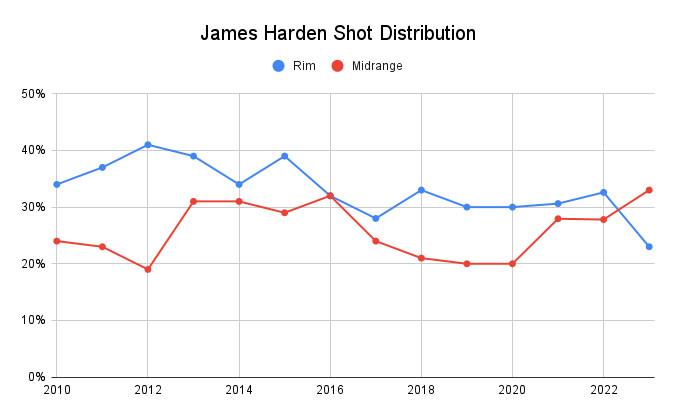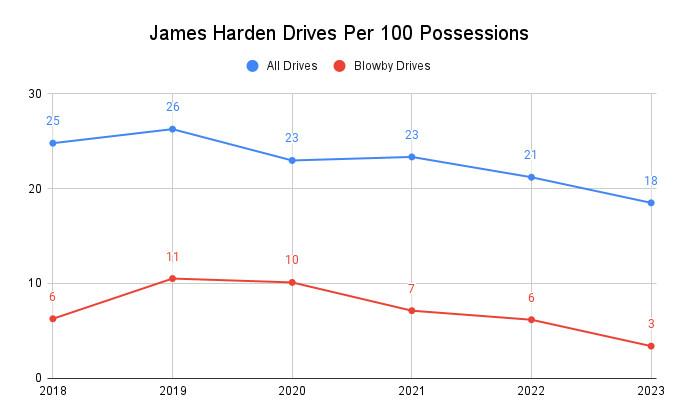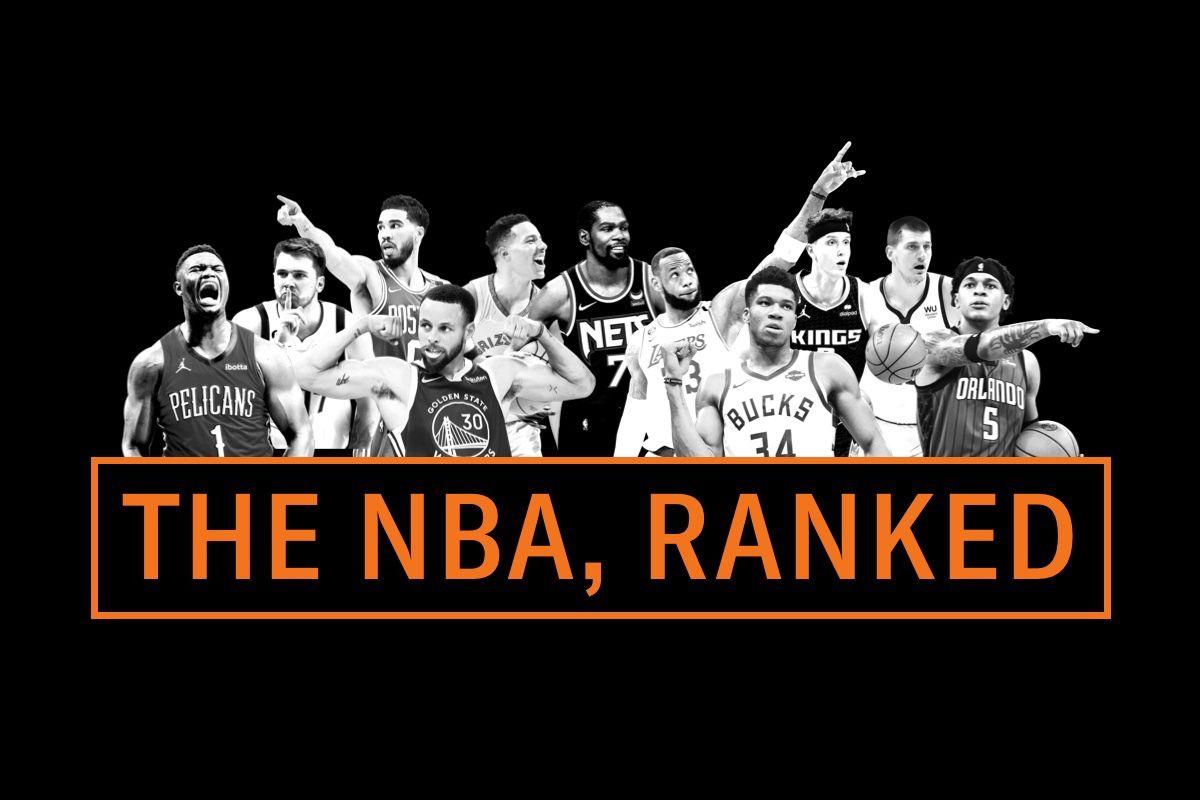
After an oddly consistent run of controversies over the past decade—from the Process to the burners, from Ben Simmons to Markelle Fultz—this season’s Philadelphia 76ers seem … relatively normal? It’s strange, I know, but the Sixers are winning, Joel Embiid is playing like an MVP, and the loud, chaotic mess of years past seems quiet for the time being.
Even if the Boston Celtics run away with the no. 1 seed, the Eastern Conference’s second spot is up for grabs. And right now, the 76ers have as strong a chance to claim it as anyone. They’re half a game out of second place in the East, with the league’s fifth-best net rating and a healthy balance between offense (11th) and defense (fourth).
In a season full of spectacular superstar performances, Embiid has been as dominant as any player when healthy. Although he’s missed 11 games so far, the two-time MVP runner-up’s 33.4 points per game ranks second in the league, and his 38 percent usage rate is third. More than ever before, the 7-footer is intent on attacking the basket. While he’s attempting 3-pointers at the lowest rate of his career, Embiid ranks eighth in the NBA in points in the paint, fourth in midrange points, and first in free throws made per game.
His free throw proficiency isn’t merely league-leading, but bordering on historic. With 9.9 free throw makes per game, Embiid is a hair away from becoming the seventh player in NBA history—and just the second since the 1980s—to reach double digits.
Single-Season Free Throw Leaderboard
Yet other than when he’s suffered untimely injuries, Embiid hasn’t been the problem in Philadelphia’s previous postseason flameouts. In four out of five playoff appearances—all but a first-round sweep in the 2020 bubble—the 76ers have had a positive scoring margin with Embiid on the floor and a negative margin without him.
76ers Point Differentials in the Playoffs
So if it seems like the 2022-23 76ers are flying under the radar despite looking like one of the most well-rounded teams in the NBA, this is why. The concern isn’t whether Embiid is ready to boost the 76ers to their best playoff showing since Allen Iverson led them to the Finals more than two decades ago. The concern is whether the supporting cast around Embiid, including new co-leads James Harden and Tyrese Maxey, is finally sufficient to help him get there.
At first blush, that supporting cast, which has been much remodeled by president of basketball operations Daryl Morey, looks ideally suited to complement Embiid’s two-way talents. Other than backup big man Montrezl Harrell and defensive ace Matisse Thybulle, every other player in the rotation can space the floor and make 3s around Embiid.
As a team, the 76ers rank fourth in 3-point percentage. Five 76ers are taking at least five 3s per game, and all five are making them at a well-above-average clip.
76ers 3-Point Shooters
The 76ers rotation is deep and versatile, too, able to toggle between big and small lineups, and play both fast in transition and slow in methodical half-court possessions. Philadelphia places in the 80th percentile in both pick-and-roll and isolation efficiency, according to Second Spectrum.
But for all the Sixers’ depth, Embiid doesn’t have a true costar to measure up against multistar outfits like the Celtics, Bucks, and Nets. Harden is no longer a top-10 player in the NBA, let alone an MVP candidate (though he might be a Rocket again soon, apparently!).
The 33-year-old guard is still a very good player, to be clear: Harden shoots well, distributes, and scores with great efficiency. The onetime isolation king isn’t atop Second Spectrum’s iso leaderboard anymore, but he’s tied with Kevin Durant and Shai Gilgeous-Alexander at 1.11 points per isolation, near the best in the league.
But there are still worrisome signs. For instance, Harden is simultaneously taking a career-high rate of his shots in the midrange and a career-low rate at the rim, according to Cleaning the Glass—which is probably not a matter of consciously trying to diversify his shot distribution, but rather an indication that he’s having trouble getting to the rim in a situation to score.

Harden’s aging, with a whole lot of miles on his tires. As old Ringer pal Dan Devine noted last month, Harden’s played the second-most combined regular and postseason minutes in the past decade, behind only LeBron James. It might not be a coincidence that Harden is driving and blowing by his defender much less often this season than any other on record. Given that Harden has never been the most successful playoff performer, even at his peak, it’s an open question whether this somewhat diminished version can succeed where previous iterations failed.

And that’s just on the offensive end. On defense, one need only watch the 76ers’ recent loss to the Thunder, when Gilgeous-Alexander and Josh Giddey combined for 57 points, to see the issues with a Harden-Maxey defensive duo on the perimeter.
Offseason addition De’Anthony Melton can help in that regard. Playing a career-high 29.5 minutes per game, Melton has surely met the 76ers’ expectations after they traded a first-round pick for him over the summer—and probably exceeded them, for casual fans who didn’t realize how much better Melton typically makes his teams. Over his three seasons in Memphis, Melton’s RAPM (an all-encompassing stat that measures a player’s impact after adjusting for the identity of his teammates and opponents) ranked 21st in the NBA.
Melton’s a sneakily effective offensive player, as both a connector in rapid-fire passing sequences and a much-improved shooter from range. He’s even creating with more confidence this season: The 76ers are scoring 1.32 points per possessions that end with a Melton-Embiid screen, fourth-best out of 212 player combos with at least 100 picks, according to Second Spectrum.
But his greatest addition is two-way balance, for a Philadelphia team rich in scoring talent and poor in backcourt defense. The 76ers will now use three different starting lineups going forward, according to coach Doc Rivers, depending on the matchup. Although he didn’t specify what they are, I’d guess they’d break down as:
- Harden, Maxey, Tobias Harris, P.J. Tucker, and Embiid, with Melton as sixth man
- Harden, Melton, Harris, Tucker, and Embiid, with Maxey as sixth man
- Harden, Maxey, Melton, Harris, and Embiid, with Tucker as sixth man
That first lineup is how the 76ers began their season and offers the most traditional alignment, but the second and third might offer the most long-term promise. In a one-point win against the Lakers on Sunday, the 76ers opted to start Melton and bring Maxey off the bench—a decision spurred by Maxey himself, as he sent Rivers a text message proposing the switch.
“I mean, sometimes, you gotta be the bigger person,” Maxey said to explain his text. “I felt like it was kind of trending toward that way.”
Coming off the bench is, in one sense, a selfless act for a young player in search of his first lucrative contract; in another, it might also allow Maxey to be more selfish and increase his involvement in the offense. When playing alongside Harden, Maxey uses 15 picks per 100 possessions, per Second Spectrum. When Maxey plays without Harden, however, that figure quadruples to 60 picks per 100, which would make him one of the highest-volume ball handlers in the league.
Highest Volume Pick-and-Roll Ball Handlers
Some of the placement on that chart stems from a team’s approach to offense. (Notice how many Suns guards are in the top 10.) But in any event, it’s clear that playing without Harden gives Maxey a much greater opportunity to flash his on-ball skills. Moreover, the 76ers can find more spots to hide Maxey on defense if he plays with bench units, separated from Harden.
But the most intriguing lineup may be that third option, because of the possibility of reducing Tucker’s workload. The 37-year-old forward ranks last among qualified players this season in points created, last in usage rate, and last in offensive box plus/minus. Defenses don’t care about his shooting “threat” at all, giving him at least 6 feet of space on 80 percent of his 3-point attempts this season.
Removing Tucker opens the possibility of playing Harden, Maxey, and Melton together, and since Maxey’s return from injury last month, the 76ers have closed several games with the guard trio. Lineups with Harden, Maxey, and Melton have outscored opponents by a robust 7.8 points per 100 possessions thus far, according to CtG, which ranks in the 91st percentile of all lineups league-wide. That combination is no great shakes defensively, but has scored an eye-popping 123.5 points per 100 possessions (98th percentile).
Translating that approach to playoff matchups against the other top teams in the East is a tough ask, though. Playing Maxey and Harden together could prove tricky against the Celtics’ balanced attack or the Cavaliers’ guard pairing of Donovan Mitchell and Darius Garland. And Rivers will probably want Tucker in the game to guard Giannis Antetokounmpo or Kevin Durant if the Sixers face the Bucks or Nets, respectively.
“It still is going to depend on the night,” Rivers said over the weekend. “If there’s someone for P.J. to guard let’s say, then we need him on the floor. If there’s no one for him to guard, then we will go with more smalls.” (However, Rivers benched Tucker down the stretch against LeBron and the Lakers on Sunday.)
With a challenging schedule in front of them, the 76ers should get a better sense of how this lineup might fare over the rest of the regular season, before they have to confront what is sure to be a gauntlet of an Eastern Conference playoff bracket. Their remaining opponents rank hardest by winning percentage and tied for second-hardest by point differential, and Philadelphia also has five more road games than home games left, the second-largest differential in the league.
But even if the guard trio can’t hold up against Giannis or Durant in a playoff matchup, at the very least, staggering minutes between Embiid and such an electric guard trio could help the team reverse its trend of hemorrhaging points in Embiid-less minutes, as it has in previous playoffs.
Because for almost the entirety of the past half-decade, Embiid has been good enough, and the 76ers good enough with Embiid, to advance far into the postseason. The supporting cast needs to excel for the team to fulfill that potential. Rivers has half a season to figure out the best lineup permutations before another playoff run begins.


